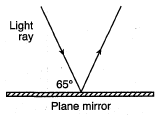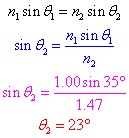Regents Physics - Wave Phenomena
Due to their very nature, waves exhibit a number of behaviors that may not be obvious upon first inspection, including the Doppler Effect, reflection, refraction, and diffraction. Understanding these behaviors brings us closer to understanding the universe, while also providing a number of useful applications including, but not limited to, radar, sonography, digital televisions, mirrors, telescopes, glasses, contact lenses, atomic research, and even holography!
Doppler Effect
The shift in a wave's observed frequency due to relative motion between the source of the wave and the observer is known as the Doppler Effect. In essence, when the source and/or observer are moving toward each other, the observer perceives a shift to a higher frequency, and when the source and/or observer are moving away from each other, the observer perceives a lower frequency.
This can be observed when a vehicle travels past you. As you hear the vehicle approach, you can observe a higher frequency noise, and as the vehicle passes by you and then moves away, you observe a lower frequency noise.
The Doppler Effect results from waves having a fixed speed in a given medium. As waves are emitted, a moving source or observer encounters the wave fronts at a different frequency than they waves are emitted, resulting in a perceived shift in frequency. The animation below may help you visualize this effect:
Question: A car’s horn is producing a sound wave having a constant frequency of 350 hertz. If the car moves toward a stationary observer at constant speed, the frequency of the car’s horn detected by this observer may be:
- 320 Hz
- 330 Hz
- 350 Hz
- 380 Hz
Answer: If source is moving toward stationary observer, observed frequency must be higher than source frequency, therefore the correct answer is (4) 380 Hz.
An exciting application of the Doppler Effect involves the analysis of radiation from distant stars and galaxies in the universe. Based on the basic elements that compose stars, we know what frequencies of radiation to look for. However, when analyzing these objects, we observe frequencies shifted toward the red end of the electromagnetic spectrum (lower frequencies), known as the Red Shift. This indicates that these celestial objects must be moving away from us. The more distant the object, the greater the red shift. Putting this together, we can conclude that more distant celestial objects are moving away from us faster, and therefore, the universe as we know it must be expanding!
Reflection
When a wave hits a boundary, three different events can occur. The wave may be:
- Reflected - wave bounces off a boundary
- Transmitted - wave is transmitted into the new medium
- Absorbed - energy of the wave is transferred into the boundary medium
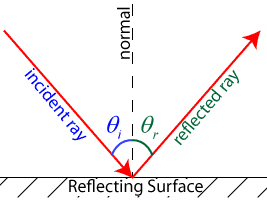
The law of reflection states that the angle at which a wave strikes a reflective medium (the angle of incidence, or ![]() ) is equal to the angle at which a wave reflects off the medium (the angle of reflection, or
) is equal to the angle at which a wave reflects off the medium (the angle of reflection, or ![]() ). Put more simply,
). Put more simply, ![]() . In all cases, the angle of incidence and the angle of reflection are measured from a line perpendicular, or normal, to the reflecting surface.
. In all cases, the angle of incidence and the angle of reflection are measured from a line perpendicular, or normal, to the reflecting surface.
Although all waves can exhibit these behaviors, electromagnetic light waves are typically considered for demonstration purposes. When a wave bounces off a reflective surface, the nature of its reflection depends largely on the nature of the surface. Rough surfaces tend to reflect light in a variety of directions in a process known as diffuse reflection. Diffuse reflection is the type of reflection typically observed off of pieces of paper. Smooth surfaces tend to reflect light waves in a more regular fashion, such that the reflected rays maintain parallel reflected rays. This process is known as specular reflection, and is commonly observed in mirrors.
Question: The diagram represents a light ray reflecting from a plane mirror. Find the angle of reflection for the light ray.
Answer: The angle of reflection must be 25°, since the angle of incidence is 25° (note that angles are always measured from the normal!)
Refraction
When a wave reaches the boundary between media, part of the wave is reflected and part of the wave enters the new medium. As the wave enters the new medium, the speed of the wave changes, and the frequency of a wave remains constant, therefore, consistent with the wave equation, ![]() , the wavelength of the wave must change.
, the wavelength of the wave must change.
Question: When a wave enters a new material, what happens to its speed, frequency, and wavelength?
Answer: Speed changes, frequency remains constant, and wavelength changes.
The front of a wave has some actual width, therefore if the wave does not impinge upon the boundary between media at a right angle, not all of the wave enters the new medium and changes speed at the same time. This causes the wave to bend as it enters a new medium in a process known as refraction.
To better illustrate this, imagine you're in a line in a marching band, connected with your bandmates as you march at a constant speed down the field in imitation of a wave front. As your wavefront reaches a new medium that slows you down, such as a mud pit, the band members reaching the mud pit slow down before those who reach the pit later. Since you are all connected in a wave front, the entire wave shifts directions (refracts) as it passes through the boundary between field and mud!
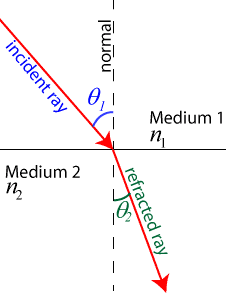
The index of refraction (n) is a measure of how much light slows down in a material. In a vacuum, all electromagnetic waves have a speed of c=3*108 m/s. In other materials, light slows down. The ratio of the speed of light in a vacuum to the speed of light in the new material is known as the index of refraction (n). The slower the wave moves in the material, the larger the index of refraction: ![]()
Question: A light ray traveling in air enters a second medium and its speed slows to 1.71 x 108 m/s. What is the absolute index of refraction of the second medium?
Answer:
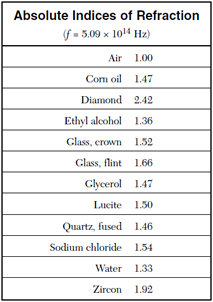
The amount a light wave bends as it enters a new medium is given by the law of refraction, also known as Snell's Law. Snell's Law states that ![]() , where n1 and n2 are the indices of refraction of the media, and
, where n1 and n2 are the indices of refraction of the media, and ![]() corresponds to the angles of the incident and refracted rays, again measured from the normal. Light bends toward the normal as it enters a material with a higher index of refraction (slower material), and bends away from the normal as it enters a material with a lower index of refraction (slower material).
corresponds to the angles of the incident and refracted rays, again measured from the normal. Light bends toward the normal as it enters a material with a higher index of refraction (slower material), and bends away from the normal as it enters a material with a lower index of refraction (slower material).
Not only does index of refraction depend upon the medium the light wave is traveling through, it also varies with frequency. Thankfully, its variation is typically fairly small, and the Regents Physics Reference Table even provides you a table of indices of refraction for common materials at a set frequency.
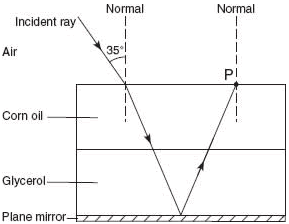
Question: A ray of monochromatic light having a frequency of 5.09 × 1014 hertz is incident on an interface of air and corn oil at an angle of 35° as shown. The ray is transmitted through parallel layers of corn oil and glycerol and is then reflected from the surface of a plane mirror, located below and parallel to the glycerol layer. The ray then emerges from the corn oil back into the air at point P.
Calculate the angle of refraction of the light ray as it enters the corn oil from air.
Answer:
Question: Explain why the ray does not bend at the corn oil-glycerol interface.
Answer: The indices of refraction are the same for corn oil and glycerol (the speed of the wave does not change at the corn-oil / glycerol interface).
Diffraction
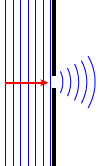
Diffraction is the bending of waves around obstacles, or the spreading of waves as they pass through an opening, most apparent when looking at obstacles or wavelengths having a size of the same order of magnitude as the wavelength. Typically, the smaller the obstacle and wavelength, the greater the diffraction. Taken to the extreme, when a wave is blocked by a small enough opening, the wave passing through the opening actually behaves like a point source for a new wave.
You can observe diffraction quite easily... I'm sure you've heard a noise from a room with an open door even when your ears aren't in a direct line from the sound source... this is a result of diffraction of the sound waves around the door opening (along with some reflection of sound as well).
Thomas Young's Double-Slit Experiment is a famous experiment which utilized diffraction to prove light has properties of waves. Young placed a single-wavelength light source behind a barrier with two narrow slits, allowing only a small portion of the light to pass through each slit. Because the two light waves travel different distances to the screen on which they are projected, you can see effects of both constructive and destructive interference, phenomena that occur only for waves!
Question: The spreading of waves into the region behind an obstacle is known as _______.
Answer: diffraction
Question: Which wave phenomenon is represented in the diagram?
Answer: diffraction


